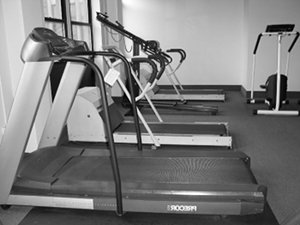Most trainees should integrate some kind of cardio in with weight training.* This will  keep your heart healthy and help you burn additional calories. As I’ve mentioned before, resistance training and cardio is a winning combination for fat loss (see: Weight Training and Weight Loss).
keep your heart healthy and help you burn additional calories. As I’ve mentioned before, resistance training and cardio is a winning combination for fat loss (see: Weight Training and Weight Loss).
I’ll divide cardiovascular training into two basic categories for the sake of simplicity:
1. Steady-state Training—going the same speed on a treadmill, exercise bike, etc. This type of training is usually more moderate (aerobic) in intensity—the trainee would not be huffing and puffing.
2. Interval Training—Hill sprints, burpees, jumping rope, etc. These kinds of exercises can be done for short periods (usually around 30 seconds to 1 minute), followed by periods of rest (usually 1-3 minutes).
Steady-state training has the advantage of being low-risk (in terms of injury) and “easy” compared with other forms of training.
Interval training has some serious advantages to consider: 1). Time efficient—burning more calories in less time 2). More practical for most athletes—almost all sports are anaerobic in nature (soccer, basketball, MMA, and the list goes on). 3). More interesting than running/walking on a treadmill.
Interval training and weight training are both efficient ways to lower glycogen (glucose stored in the muscle and liver).
The simplest way to integrate cardio is to do it on a day you don’t train with weights. But time constraints may not allow this, or you may just prefer the convenience of doing everything while you are at the gym.
I’d highly recommend you do your cardio training after your resistance training if you want to do both in the same day/session. It just makes sense to lift weights when your energy and glycogen levels are still high. Warming up on the treadmill for a few minutes is OK, but lifting weights when you are already tired seems like a setup for injury.
Interval training after you lift could be used as a “finisher” to your workout—a way to improve your overall conditioning and increase the calorie deficit created by your workout (Renegade Cardio would work very well here).
Steady-state cardio can burn fat by taking advantage of low glycogen levels created during resistance training (another reason I suggest doing weights first).
Either strategy could be used help you reach your goal of fat loss and better overall health. But I’ll remind you again: fat loss only happens when you have created a negative calorie balance through diet.
*About the only exception I can think of here is super-skinny types who are struggling to put on mass. They may want to avoid cardio for their first few months of training. But even they should eventually consider adding it in some form eventually.